Dianna Cohen: Getting the Message from Her Own Art
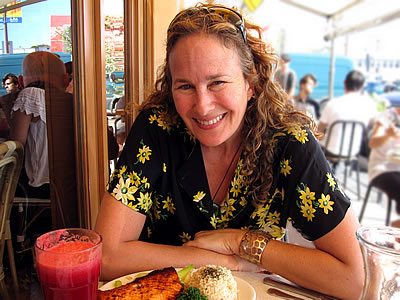 Dianna Cohen is a painter, but she doesn’t use a paint brush. Trained at UCLA, she gave up the brush for materials most people consider trash: bags, boxes, little pieces of plastic. This year, she helped to found the Plastic Pollution Coalition. After twenty years, she finally started to get the messages from her own art. During my weekend in L.A., Dianna put me up in her art studio. I got to live with her artwork for three days and pick up a few messages myself.
Dianna Cohen is a painter, but she doesn’t use a paint brush. Trained at UCLA, she gave up the brush for materials most people consider trash: bags, boxes, little pieces of plastic. This year, she helped to found the Plastic Pollution Coalition. After twenty years, she finally started to get the messages from her own art. During my weekend in L.A., Dianna put me up in her art studio. I got to live with her artwork for three days and pick up a few messages myself.
Over lunch, Dianna explained to me about her art process and her passion for protecting the environment. While in college, she became intrigued with the different shades of brown paper bags and began creating collages, stitching them together with a needle and thread. One of my favorite pieces is this beautiful abstract piece made with cardboard boxes:
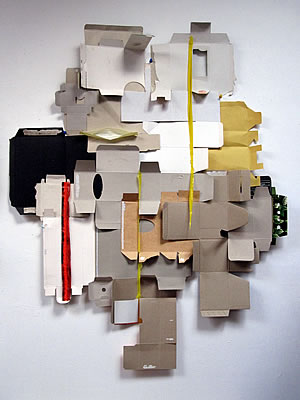
Her interest in plastic bags arose at a homeopathic shop in Belgium that provided the bags with colorful flowers printed on them. Dianna noticed the irony of the natural image against the synthetic material and began creating collages from plastic bags, arranging the printed text and images to create messages that even she didn’t always understand.
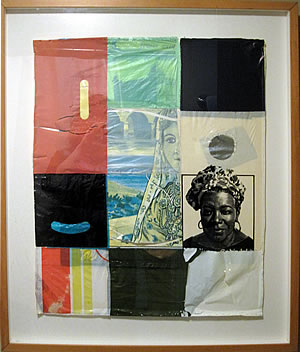
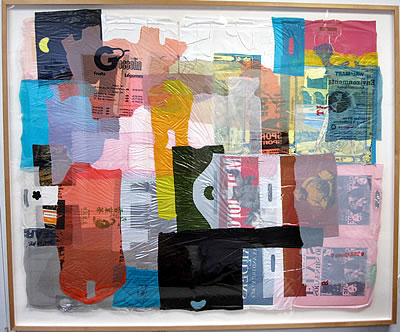
After about eight years of working with plastic, she noticed that some of the materials had begun to crack and flake, leaving tiny pieces of plastic inside their frames.
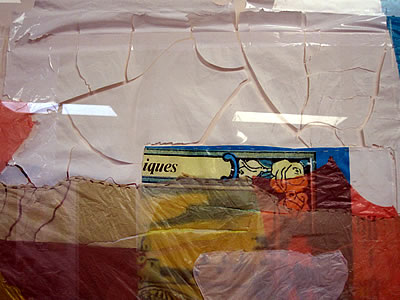
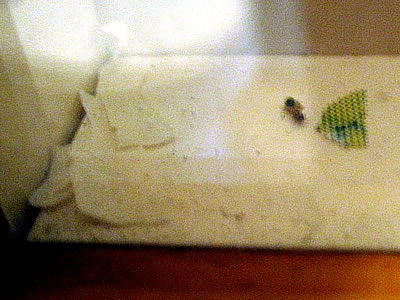
Honestly, when I saw these pieces, I thought the cracks were intentional. They seemed so organic and right. I think it was then that I started to understand some things about plastic. There is beauty in it. It’s harmful to our health and our planet. But we cannot deny that it can be visually beautiful and even enticing. Perhaps this is part of its appeal?
Anyway, dismayed that her art was not as archival as she once thought, Dianna changed her perspective and began to realize that the disintegration of the plastic was part of the message of the piece. While plastic molecules might last forever in the environment, the plastic products themselves can break down into smaller and smaller pieces, releasing their chemicals and doing even more damage than if they remained intact.
And then, looking at the recycling under her own sink one day, she started to wonder why she was throwing away so many perfectly good materials in the first place. And to question what actually happens to them in a single stream recycling system. Starting with cereal boxes, she began to collect other kinds of “trash,” like bottle caps and those little square plastic bread bag fasteners (whatever they’re called) to use in her art.
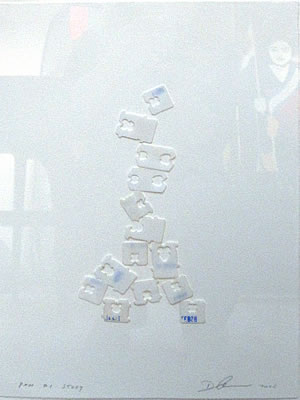
And she’s become more active in working to stem the tide of waste, especially plastic pollution. She can’t shop in Trader Joe’s anymore (dubbed “Trader Blows” by several people over the weekend) because of the amount of plastic packaging the store uses. And she had a melt down at the food coop she’d been shopping at for years when she went in one day and realized there was almost nothing she could buy that wasn’t packaged in plastic.
Her artwork too has expanded its boundaries, no longer confined to flat collage pieces in frames. Now, it bursts from the walls and mingles with elements from the natural world.
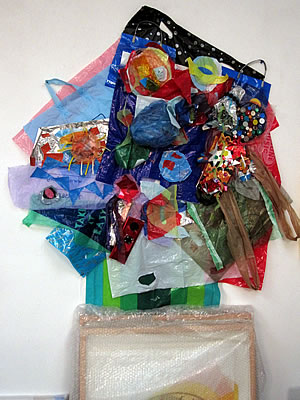
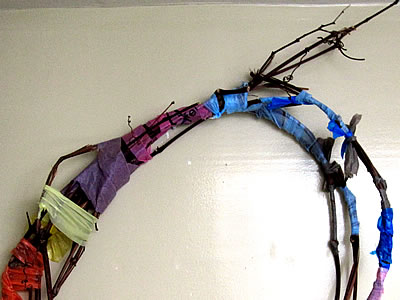
But I think my favorite piece of all is a tiny Styrofoam peanut nestled together with a twig atop a blue jar hidden in a corner of the studio. The message is simple and profound. This is what we have done. Deceptively sweet. Dangerous in it utter mundanity.
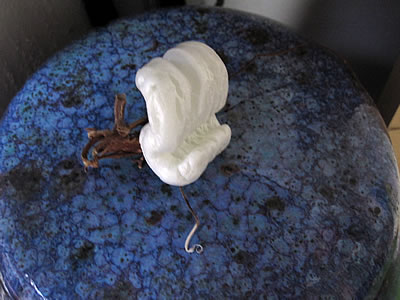








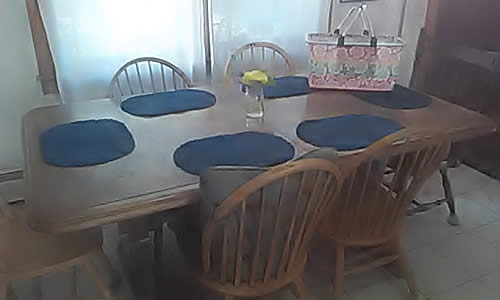

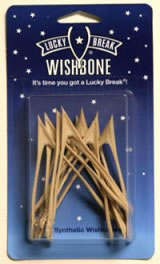
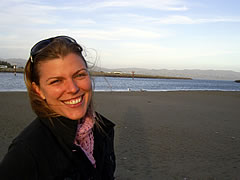
Hi Beth,
Functionality is a related aspect of plastic where good performance is temporary. I have 2 examples of this with a plastic-topped salt cellar. The salt has worn away the thread of the cap, by abrasion, leading to loss of function. The other example is basin/bath stoppers where the seal between them and metal rims is not tight compared to the old rubber type.
We have compromised quality in materials for the cheap alternative which has lowered the standard of usage.
You said “(she)…began creating collages from plastic bags, arranging the printed text and images to create messages that even she didn’t always understandâ€
So true of all of us – we are set free for a few decades with our incredible neurological system of sensations and impressions that go far far beyond words or the ability to express concretely the impact of our environment on us. We are a living kaleidoscope, looking out and in at the same time, yet spend much of our time imaginatively looking at the ground.
Art asks us to see differently and without the need to speak of what we see. Dianna knows what she is doing and we do too because of the response we have when we look at her work…no words for it…the common ache of the contemplation of beauty in the mind of the creator and the viewer.
Yet how oblivious we are!
The common plastic bag: a dozen arranged make for beauty that we would pay to own, yet millions fly in the breeze with no value to us, discarded, past a moment’s use and about the work of harm that is their real function.
What irony! The physical world does not honor our values, our need to carry an item for a few minutes. We wave this off saying, “but long term harm isn’t our intent!†We can be so attentive, so appreciative, so sensitive and at the very same time so obtuse, as oblivious to fact as a stone. Can there be more conceit? Humanity, you astound!
Hi Pure Mothers,
Unpackaged, a shop in London, lowers charges for home container purchases and sells a broad range of food and other items.
You can get more ideas from Mrs Green on MyZeroWaste the main site for our UK trend:
http://www.myzerowaste.com/,
oh , her work is fabulous, beautiful. thank you so much for sharing. Collage can present such an intriguing message.
it is so true about the power of collage and how it speaks often things you have no idea about …i use the medium myself and love it’s insights. Her work is a fabulous exampling
Sublime. I wish there were more of you.
What beautiful work! I too loved the colorful branch and all of the collages.
The branches wrapped in plastic took my breath away.
Excellent post, Beth
Art can tell complex stories in a direct and compelling way that touches our hearts. That’s why I believe art is one of the most powerful tools we have to raise awareness on environmental problems in general and on plastic pollution in particular.
In addition to being a terrific leader and coalition builder for the Plastic pollution Coalition, Dianna is an incredibly talented and sensitive artist. I’m delighted to see that you connect with her art so deeply. Thank you for sharing this with us.
-manuel
Thanks for sharing Beth. What a wonderful artist. I have been a bit depressed since moving to London. Everything is wrapped in plastic. I mean, everything! I am trying so hard to avoid it. But it’s nearly impossible. The sheer number of people that live here – and stores need to provide safe food for them – I must surmise that plastic protects the food from germs since so many people walk past each item daily.
I am trying though. At least I walk and bike now – and rarely drive anymore.
I’m still tuning in – and I hope to start blogging again soon.